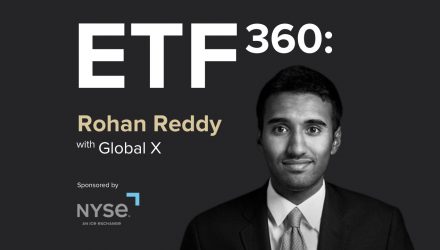In this episode of “ETF 360,” VettaFi’s head of research Todd Rosenbluth spoke with Rohan Reddy, director of research at Global X, to discuss covered call strategies.
Advisors and investors are feeling income challenged within their portfolios this year in the current global rising rate environment that has many central banks around the world becoming increasingly hawkish.
“For investors today we’re seeing a lot of assets move towards the real asset space, including energy, commodities like copper; those are a couple of ideas,” Reddy explained. “We’re also seeing alternative sources of income such as higher yield in fixed income and the preferred stock and high yield bond space.”
Yet another income source that advisors and investors have sought out has been through derivatives, particularly options like puts and calls and also covered calls. A call option is when a buyer of the call contract has the right to purchase the underlying security at an agreed upon price at a set date in the future, but they aren’t obligated to do so.
A covered call is when a call is written on an underlying asset that is already owned or bought at the time that the call is written, such as a security or even an index. Writers of covered calls collect a premium from the buyer of the covered call, which is kept whether the call is exercised or not. It creates an income stream for the seller and is best used in an environment where short-term stock gains are anticipated to be minimal.
“You’re essentially monetizing volatility,” Reddy explained. “For investors what you’re doing is you’re continuing to stay invested in the equity markets in this case and then you’re also benefiting from the fact that volatility is increasing which is typically a headwind for most equity and fixed income asset classes.”
The Covered Call Suite From Global X
Global X offers a variety of covered call ETFs, including the Global X S&P 500 Covered Call ETF (XYLD) and the Global X S&P 500 Covered Call & Growth ETF (XLYG).
XLYD is a passive fund that utilizes a rules-based approach to buy all of the stocks within the S&P 500, weight them to reflect the weighting of the index, and then writes a 100% notional at-the-money call option on the S&P.
“What makes index options a little bit more unique compared to American options is they cannot be exercised early and they’re all-cash settled so it makes it easier from an investor standpoint, especially in the ETF structure, to be able to manage that and we do so with one month in-duration at-the-money call options,” Reddy said.
In an environment where the economy is beginning to give potential indicators that it has peaked, Global X believes that we are entering a point of late-cycle activity levels. Funds like XYLD and XYLG offer potential income opportunities as well as the ability to potentially time an economic downturn in markets.
Both ETFs offer advisors and investors a way to express their outlook on market direction: XYLD offers greater premium potential because of a 100% notional value call on the S&P at the money while XYLG only writes 50% of the notional value and therefore leaves space for anticipated equity upside movement.
“From a strategic investor’s perspective, it’s really ultimately up to where can you kind of see the balance of income and growth and which do you have a strong preference for, and for a tactical investor it could be the decision of, maybe where do I see the market going today,” Reddy explained.
For more ETF 360 videos, visit our ETF 360 Channel.

